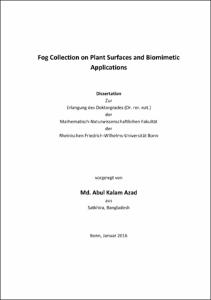Azad, Md. Abul Kalam: Fog Collection on Plant Surfaces and Biomimetic Applications. - Bonn, 2016. - Dissertation, Rheinische Friedrich-Wilhelms-Universität Bonn.
Online-Ausgabe in bonndoc: https://nbn-resolving.org/urn:nbn:de:hbz:5n-43931
Online-Ausgabe in bonndoc: https://nbn-resolving.org/urn:nbn:de:hbz:5n-43931
@phdthesis{handle:20.500.11811/6777,
urn: https://nbn-resolving.org/urn:nbn:de:hbz:5n-43931,
author = {{Md. Abul Kalam Azad}},
title = {Fog Collection on Plant Surfaces and Biomimetic Applications},
school = {Rheinische Friedrich-Wilhelms-Universität Bonn},
year = 2016,
month = jun,
note = {Shortages of fresh water affect around one billion people world-wide; mostly in arid and semi-arid climates. Fog, in certain regions, may be an important source of water that is often overlooked. Inspired by the distinctive fog-collection mechanisms of certain plants surviving in these climatic conditions, biomimetic fog collectors are an innovation that could enable us to alleviate the water shortages. The influence of leaf shape, surface microstructure and hierarchical architecture, and wettability of plant and biomimetic samples on their fog-collection efficiency is analyzed. A pinnate leaf shape shows higher efficiency compared to perforate or simple leaf shapes as a result of a lower flow resistance of the fog droplets transported by air, as well as sufficient space on the surfaces for their deposition. Pinnate and perforate leaf shapes were prepared by experimental modification of simple leaves. Directed channels on the surfaces and a drip tip at the lower edge of leaf samples improve the transport of water. Adhesion of a thick water layer at the bottom edges of the samples without the drip tip results in the saturation of the surfaces and a lower efficiency. Microstructured surfaces show two to three times higher efficiency over smooth surfaces. A continuous fog droplet deposition, an effective water transport to the target and a very efficient fog collection is found in dry hydrophilized Hordeum vulgare (barley) awn with hierarchical architecture. A unique fog-collection ability is demonstrated by the structured trichomes of Ptilotus manglesii. Polymer fibers with microgrooved surface demonstrates a higher water transport (drainage efficiency) than different other fiber profiles with smooth surface, resulting in the increase of total fog collection. Numerical simulation supports the findings. Superhydrophilic surface property plays a major role to enhance the deposition efficiency as well as transport of water droplet, i.e., superhydrophilic meshes collect twice as much fog as hydrophobic meshes and five times as much fog as hydrophilic meshes. Therefore, fibers with a combination of optimized diameter and microgrooved superhydrophilic surface can enhance the efficiency. In conclusion, a new fiber design with a hierarchical architecture and superhydrophilic surface is proposed to develop optimized meshes for fog collection.},
url = {https://hdl.handle.net/20.500.11811/6777}
}
urn: https://nbn-resolving.org/urn:nbn:de:hbz:5n-43931,
author = {{Md. Abul Kalam Azad}},
title = {Fog Collection on Plant Surfaces and Biomimetic Applications},
school = {Rheinische Friedrich-Wilhelms-Universität Bonn},
year = 2016,
month = jun,
note = {Shortages of fresh water affect around one billion people world-wide; mostly in arid and semi-arid climates. Fog, in certain regions, may be an important source of water that is often overlooked. Inspired by the distinctive fog-collection mechanisms of certain plants surviving in these climatic conditions, biomimetic fog collectors are an innovation that could enable us to alleviate the water shortages. The influence of leaf shape, surface microstructure and hierarchical architecture, and wettability of plant and biomimetic samples on their fog-collection efficiency is analyzed. A pinnate leaf shape shows higher efficiency compared to perforate or simple leaf shapes as a result of a lower flow resistance of the fog droplets transported by air, as well as sufficient space on the surfaces for their deposition. Pinnate and perforate leaf shapes were prepared by experimental modification of simple leaves. Directed channels on the surfaces and a drip tip at the lower edge of leaf samples improve the transport of water. Adhesion of a thick water layer at the bottom edges of the samples without the drip tip results in the saturation of the surfaces and a lower efficiency. Microstructured surfaces show two to three times higher efficiency over smooth surfaces. A continuous fog droplet deposition, an effective water transport to the target and a very efficient fog collection is found in dry hydrophilized Hordeum vulgare (barley) awn with hierarchical architecture. A unique fog-collection ability is demonstrated by the structured trichomes of Ptilotus manglesii. Polymer fibers with microgrooved surface demonstrates a higher water transport (drainage efficiency) than different other fiber profiles with smooth surface, resulting in the increase of total fog collection. Numerical simulation supports the findings. Superhydrophilic surface property plays a major role to enhance the deposition efficiency as well as transport of water droplet, i.e., superhydrophilic meshes collect twice as much fog as hydrophobic meshes and five times as much fog as hydrophilic meshes. Therefore, fibers with a combination of optimized diameter and microgrooved superhydrophilic surface can enhance the efficiency. In conclusion, a new fiber design with a hierarchical architecture and superhydrophilic surface is proposed to develop optimized meshes for fog collection.},
url = {https://hdl.handle.net/20.500.11811/6777}
}






